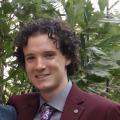Dr. Melanie Alpaugh

The Alpaugh lab utilizes human tissue samples, mouse models and cell culture systems to investigate protein misfolding in neurodegenerative diseases. Currently we are exploring 1) the role of tau in Huntington’s disease using human plasma and tissue samples; 2) the effects of cardiovascular disease on protein misfolding in mouse models and human tissue samples; 3) how environmental stressors influence aggregation of different commonly misfolded proteins in cell culture. To complete these studies we incorporate behavioural analysis, biochemical methods, imaging and complex statistical analyses to gain a holistic understanding of the consequences of different interventions.
2010- B.Sc. Honors (Neuroscience), University of Alberta
2016- Ph.D. (Neuroscience), University of Alberta
2016-2017- Postdoctoral Fellow, University of Alberta
2018-2022- Postdoctoral fellow, Université Laval
Research
The overarching goal in the lab is to understand the mechanisms and consequences of protein misfolding in neurodegenerative conditions. To enhance the clinical applicability of findings and to facilitate the discovery of shared mechanisms, studies are completed in models of multiple neurological disorders. Furthermore, a combination of human tissue samples, human cell culture models and mouse models will be used to ensure relevance to human disease.
Theme 1. Understanding interactions between the vascular system, blood-brain barrier break down and the accumulation of misfolded proteins
Cardiovascular disease is an important risk factor for the development of cerebral vascular changes, blood-brain barrier disruption and dementia. In the Alpaugh lab we aim to understand how changes to the cardiovascular system effect the blood-brain barrier and protein accumulation in different neurological conditions by using human tissue samples, mouse models and a 3D-cell culture model of the blood-brain barrier.
Theme 2. Assessing the impact of environmental factors on protein misfolding
The presence of abnormal protein aggregates in the brains of patients with neurodegenerative diseases has been described since the initial characterization of many of these disorders. Initial studies had described one or two proteins to accumulate in each condition, however, more recent work has indicated that many more proteins may be present within these aggregates. In the Alpaugh lab we aim to understand the mechanisms that drive the accumulation of secondary proteins within neurodegenerative diseases.
Selected publications
1. Tan K, Alpaugh M, Ashton NJ, Chouinard S, Barker RA, Blennow K, Zetterberg H, Cicchetti, F, Benedt AL; 2023; Plasma GFAP and its association with disease severity in Huntington’s disease; Journal of Neurology; online ahead of print. https://doi.org/10.1007/s00415-023-12109-y.
2. de Rus Jacquet A#*, Alpaugh M#, Denis HL, Tancredi JL, Boutin M, Decaestecker J, Beauparlant C, Herrmann L, Saint-Pierre M, Parent M, Droit A, Breton S, Cicchetti F*; 2023; The contribution of inflammatory astrocytes to BBB impairments in a brain-chip model of Parkinson's disease.; Nature Communication;14(1):3651. doi: 10.1038/s41467-023-39038-8. #co-first authors, *co-corresponding authors
3. Alpaugh M*, Masnata M*, de Rus Jacquet A, Lepinay E, Denis HL, Saint-Pierre M, Davies P, Planel E and Cicchetti C; 2022; Passive immunization against phosphorylated tau improves features of Huntington’s disease pathology; Molecular Therapy; S1525-0016(22)00020-X. doi: 10.1016/j.ymthe.2022.01.020. Online ahead of print. *co-first authors
4. Alpaugh M, Denis HL and Cicchetti F; 2021; Prion-like properties of the mutant huntingtin protein in living organisms: the evidence and the relevance; Molecular psychiatry; doi: 10.1038/s41380-021-01350-4. Online ahead of print.
5. Alpaugh M^ and Cicchetti F^; 2021; Huntington’s disease: Lessons from prion disorders; Journal of Neurology; 268(9):3493-3504. doi: 10.1007/s00415-021-10418-8.
^co-corresponding authors
6. Rieux M*, Alpaugh M*, Sciacca G, Saint-Pierre M, Masnata M, Denis HL, Levesque SA, Hermann F, Bazenet C, Garneau AP, Isenring P, Truant R, Oueslati A, Gould PV, Ast A, Wanker EE, Lacroix S and Cicchetti F; 2020; Shedding a new light on Huntington's disease: how blood can both propagate and ameliorate disease pathology; Molecular Psychiatry; epub ahead of print. doi: 10.1038/s41380-020-0787-4.
*co-first authors
7. Masnata M*, Sciacca G*, Maxan A*, Lauruol F, David L, Dénis H, Saint-Pierre M, Bousset L, Melki R, Kordower J, Alpaugh M^, Cicchetti F^; 2019; Demonstration of prion-like properties of mutant huntingtin fibrils in both in vitro and in vivo paradigms; Acta Neuropathologica; 137(6):981-1001. doi: 10.1007/s00401-019-01973-6.
8. Alpaugh M, Galleguillos D, Forero J, Morales LC, Lackey SW, Kar P, Di Pardo A, Holt A, Kerr BJ, Todd KG, Baker GB, Fouad K and Sipione S; 2017; Disease-modifying effects of ganglioside GM1 In Huntington’s Disease models; EMBO Molecular Medicine; 9(11):1537-1557. doi: 10.15252/emmm.201707763.
LAB MEMBERS
Graduate Students

Jason Cousineau

Aimee Dawe
NEUR*3100
NEUR*3500